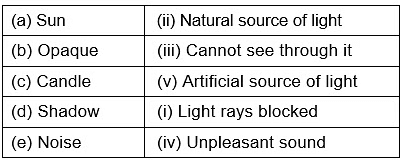Class 3 Science - Light Sound and Force - CBSE Worksheets Solutions
Q1: Multiple Choice Questions
(i) Light helps us to
(a) listen
(b) speak
(c) see
(d) eat
Ans: (b)
This reflection of light is what enables us to see everything around us.
(ii) Which of these is true for your shadow?
(a) It is always black.
(b) It is of the same colour as your clothes.
(c) It is always the same size as you.
(d) It is only for med when it is dark.
Ans: (a)
A shadow is caused by an object blocking light so that it does not reach a surface. The area in shadow appears black because there is no light falling on it.
(iii) Which of these is a pull?
(a) Kicking
(b) Lifting
(c) Hitting
(d) All of these
Ans: (b)
To pull the same object would depend on the friction between the object and the surface.
(iv) Which of these kinds of substances allows the least amount of light to pass through?
(a) Transparent
(b) Translucent
(c) Opaque
(d) Glass
Ans: (b)
Translucent objects allow light to pass through them but they distort it. Example: frosted or stained glass. Opaque objects do not allow light to pass through them. Example: brick walls, human beings.
(v) In which of these is a force not being applied?
(a) Reading a book
(b) Trying to push a table
(c) Kicking a football
(d) Throwing up a ball
Ans: (a)
Reading a book does not require force. A force can either be a push or pull that is enacted upon an object. When a force acts upon an object it will result in a change in speed and/or direction.
Q2: Give two examples of the following.
(a) Transparent things Glass, Water
(b) Push Kicking a football, Opening a door outwards.
(c) Pleasant sound Waterfall sound, sound of birds
(d) Pull Opening a door inwards, picking up a glass of water.
EduRev Tips:
- Materials like air, water, and clear glass are called transparent. When light encounters transparent materials, almost all of it passes directly through them.
- A push is when you move things away from you. An example of a push is when you push a basketball toward the hoop.
- Pleasant sound can be defined as the sound which makes you feel happy . examples of pleasant sound can be. sound of a river flowing.
- The pull is defined as the force that is responsible for an object to move from the state of rest but in the opposite direction when compared to the push.
Q3: True & False
(i) Light travels in straight lines. True
(ii) Unpleasant sound can cause headache. True
(iii) A force can change the weight of an object. False
(iv) We can clearly see through opaque objects. False
(v) We use force only when we push something. False
EduRev Tips:
- Light travels in straight lines primarily due to the fact that light is a wave.
- Unpleasant and Loud noises intensify the pain of the headaches.
- The mass of an object cannot be changed by force because mass is a property of an object which cannot be changed but the shape or speed or the direction can be changed by force.
- Translucent objects allow light to pass through them but they distort it. Example: frosted or stained glass. Opaque objects do not allow light to pass through them. Example: brick walls, human beings.
- A force can either be a push or pull that is enacted upon an object. When a force acts upon an object it will result in a change in speed and/or direction.
Q4: Tick the sounds which you think will make you happy.
(a) Birds chirping (YES)
(b) Cars honking (NO)
(c) Rustling leaves (YES)
(d) Someone singing softly (YES)
(e) Loud music (NO)
(f) Children quarrelling (NO)
Q5: Fill in the blanks
(a) Beam of light is called directional projection of light energy being radiated from a light source.
(b) Unpleasant sound is called noise.
(c) Force can change the motion of a moving object.
(d) A shadow for ms on the opposite side of the light.
(e) A push or pull is a force.
EduRev Tips:
- A light beam or a beam of light is defined as a directional projection of light energy being radiated from a light source. The direction or the path along which light travels is called the ray of light. It is represented by a straight line and an arrow marked on it.
- Unwanted or unpleasant sounds are known as noise. Sounds that are melodious and pleasing to the ear are known as music.
- A push or pull can change the speed of a moving bicycle. If the force is applied in the direction of motion of the object, its speed increases. If the force is applied in the direction opposite to the direction of motion of an object then its speed decreases.
- When an opaque object is placed in the path of light, the path of light is obstructed and a dark patch is formed on the ground. This dark patch is called the shadow of the opaque object. Shadow is always formed on the opposite side to that of light.
- A force can either be a push or pull that is enacted upon an object. When a force acts upon an object it will result in a change in speed and/or direction.
Q6: Match the following

Ans:

Answer the following questions
Q7: What is the difference between luminous and non-luminous objects? Give two examples of each.
Ans: luminous objects can emit light energy so they are seen on their own but non luminous objects do not emit light energy on their own, so they are seen due to luminous bodies not by their own. The sun and candle are the two examples of luminous objects and the moon and planets are the examples of non-luminous objects.
Q8: What is the difference between transparent and translucent objects? Give two examples of each.
Ans: Materials like air, water, and clear glass are called transparent. Glass, for example, is transparent to all visible light. Translucent objects allow some light to travel through them. Materials like frosted glass and some plastics are called translucent.
Q9: How is a shadow formed?
Ans: Shadow is formed when light is not able to pass through an opaque object. When an opaque object comes in the path of the light, the light falling on that object cannot reach the other side, therefore, that particular region becomes dark.
Q10: What can force do?
Ans: Force changes the motion of the body that is already in motion. Example: When we push harder to move a toy car, its speed increases. Similarly we can apply force in the opposite direction of the motion to slow down the speed of the toy car.
|
19 videos|48 docs|30 tests
|
FAQs on Class 3 Science - Light Sound and Force - CBSE Worksheets Solutions
| 1. How does light travel? |  |
| 2. What is the difference between sound and light waves? |  |
| 3. How does force affect the motion of an object? |  |
| 4. How do light and sound interact with each other? |  |
| 5. Can force affect the speed of sound and light? |  |

|
Explore Courses for Class 3 exam
|

|


















